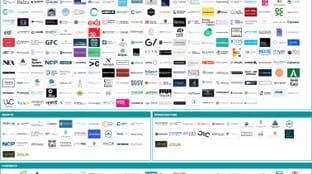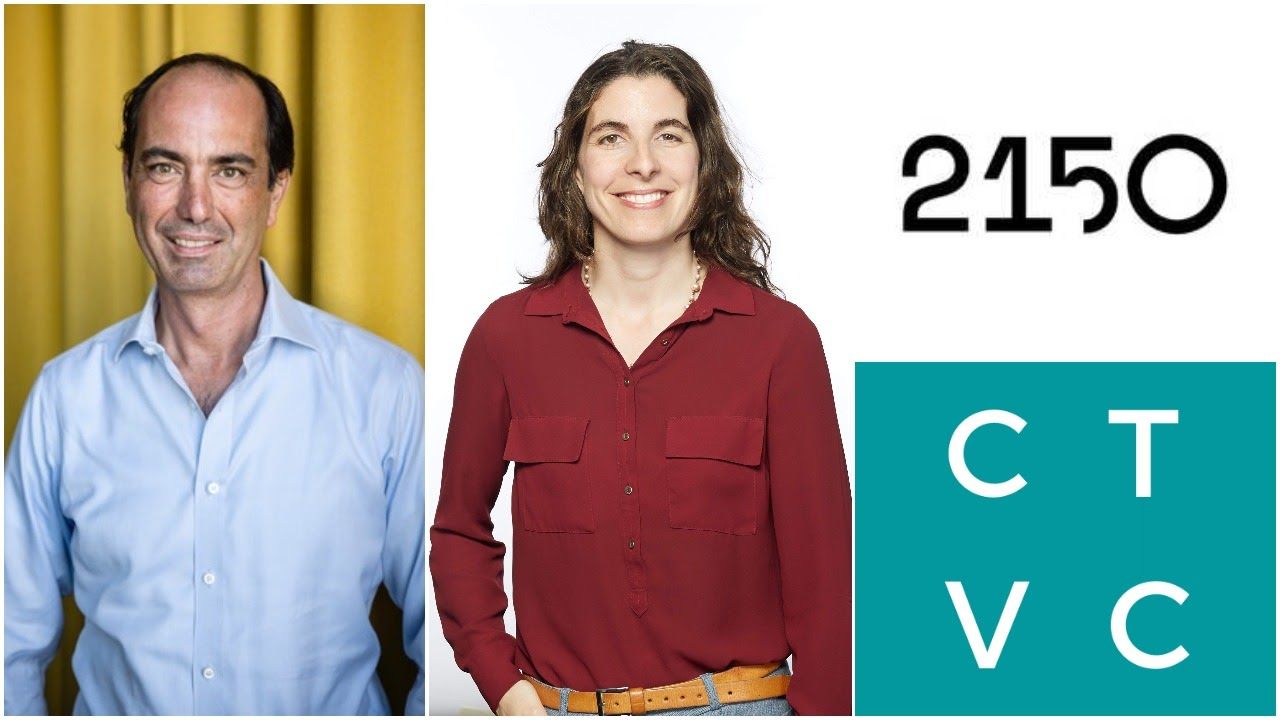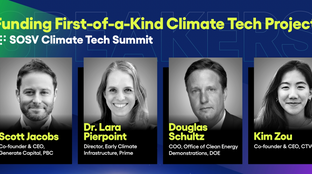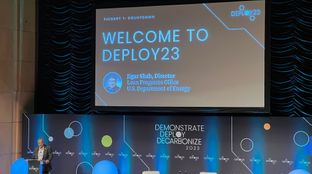
🌏 Who are the Climate Tech Investors?
A new interactive Climate Capital Stack Map
Delving into the ‘Urban Tech Stack’ with 2150

“Cute little impact fund that you’ve got there!” Christian Hernandez jokes at the launch of 2150’s debut $312m fund. Hernandez, Nicole LeBlanc, and their co-founding team have been around big construction, urban tech, and institutional funds before but are bringing their diverse experiences and capital to the yard to invest across ‘The Urban Stack’. In a riff on Silicon Valley’s hunt for the elusive Unicorn, 2150 has their sights set on a new, greener breed - the Gigacorn, or commercial companies which can mitigate a Gigaton of Co2 / yr. 2150 hunts Gigacorns globally, but has roots across Europe, where we Zoomed in to London and Copenhagen to chat with Christian and Nicole for this conversation pre-COP26.
Your team comes from a variety of backgrounds including venture, tech, industry, and climate. How did you all come together to build 2150?
Christian: As we were going to raise our third fund for my venture fund, White Star Capital, I had a moral crisis. I wanted to back companies with a greater impact than fashion e-commerce or scooter brands - but, I needed a different platform to do it. So, I fired myself and spent a year trying to figure out the best vector of attack to quickly move the needle. I came to the realization that the urban environment is that vector - it hosts 70% of the world's GHG emissions and 50% of the world's population.
My partner Mikkel’s last startup was a $12b AUM real estate private equity fund, NREP. He built and redeveloped whole sections of Copenhagen, Helsinki, and Stockholm into some of the most beautiful, sustainable neighborhoods and, despite that, knew that climate change would still screw us. His question of “how do we do sustainable development at scale?” led him to incubate what would become 2150. Solving this climate problem means that we can't just think about the building - we need a broader approach than proptech or construction tech. Buildings are 100-year assets, which means that 2050 is too short to solve all the layers of the urban environment. We’re thinking long term to get to a sustainable 2150, which is what we named the fund after.
Mikkel also brought onboard Jacob, the Chief Product Officer at Rocket Internet, and “the other” Christian, who came from an industrial and sustainability background. While we all brought unique experiences in investing, company building, and climate, we realized we wanted someone with urban subject expertise - which is what led us to Nicole.
Nicole: I've been in VC for almost 15 years and spent the last couple of years in urban tech and sustainability with Sidewalk Labs. When Sidewalk decided not to pursue the Toronto project, it was a sad day for us but I knew I wanted to stay in the space. The alignment with 2150 was really just perfect. We have built a problem driven thesis and are focusing on collaboration with LPs to collectively solve problems. This is the value added approach to venture that I believe will drive results. I also love urban tech because of its breadth - disruptive innovation happens at the intersection of verticals, such as where the built environment meets energy or mobility. I identified with 2150’s core vision and love working with these kinds of complex systems, so I moved across the Atlantic with my bicycle to Copenhagen.
Did you have any personal experiences with climate and urbanization that instilled your passion for the subject?
Christian: I’m from El Salvador, where a lot of the people migrating away could be classified as climate refugees. Agriculture yields are massively down, there’s no temporal employment, and crime is a big issue. After reading about climate refugees in the first chapter of The Uninhabitable Earth, I realized how personal the issue was to me. I thought – oh my God I could actually have an impact on my home country and their lives.
Nicole: I’m from a town of 1,000 people on the east coast of Canada and had no experience as a child with cities. My whole lens comes from small towns and their connection to community and nature. So I try to apply that viewpoint and bring all those wonderful things to the urban environment.
2150 invests in “The Urban Stack”. What does that mean and how does it impact how 2150 invests?
Christian: We invest in technologies that make cities more efficient, sustainable and resilient while aiming for better climate and health outcomes. The subtext is that we look at materials, the flow in and out of cities, the energy that powers cities - how you build, heat, cool, move things around, and keep people safe and secure. We have a vertical thesis, but I would argue it is the world's largest vertical.
Nicole: For me, the Urban Stack represents our area of expertise where we can look up and down the value chain and take advantage of synergies within our portfolio. It makes sense for our founders to talk to one another, to be able to share their learnings and expertise. We invested in CarbonCure - a company that sequesters CO2 into concrete. Following that investment we have to ask: what are the other types of investments that we can make that add value, and can work together to help support the same customer or amplify their work?
Where has urbanization failed the climate in the biggest ways? How does the Urban Stack address this?
Christian: Richard Florida sits on our advisory board, and he is a famed urbanist and Twitter champion of the belief that cities are good for humanity. I for the most part agree with him, but building a city is massively negative for the planet - whether it’s pouring concrete like it’s water or using steel to build giant structures. Cities are going to grow tremendously, especially in places like Dar es Salaam and regions that the average Westerner couldn’t even place on a map. So, it’s not only thinking about cities in Europe or the US, it's about accelerating sustainable urbanization around the world.
The reason we call it The Urban Stack is because we think about the different layers of a city that are interdependent. For example, Jakarta was never designed to support 27m people. The sewage pipes are literally overflowing. So the government is withdrawing from Jakarta and building a new city in the middle of some new islands. Unless you think about the interconnected layers, the city will crumble.
The Urban Stack thesis brings a structured approach to not only reviving or retrofitting a city, but bringing in new elements. To do that, you have to understand how all of these things work up and down the value chain - from the urban planners and mayor’s office down to the real estate developers and infrastructure builders. You need to think about system wide solutions.
There are many ties between urbanization, inequality, and climate change. How does climate justice play into the thesis of 2150’s Urban Stack?
Christian: It’s a part of our framework. We’ve looked at a few investments where the primary point of deployment is social housing because those structures actually have the highest tax from an inefficient energy or building environment perspective.
Nicole: We’ve also had multiple discussions around climate refugees. Geographically, a number of countries will actually fare better from climate, while others - like in the Global South - will be the hardest hit. The question of “How do these countries prepare for both the social and physical elements of this change?” colors how we think about our investments.
Christian: Right now, it’s the job of the EU and US to be the first adopters and accept the premium on climate technologies so that they can be deployed at scale in places like Lagos, Nigeria. I got in a Twitter fight with somebody after I suggested that we can’t force India to stop developing, but we can find solutions to make their cooling more efficient at cost-parity. That’s the leading role we’re playing in Europe by adopting new climate technologies quickly and accepting an initial price premium.
Nicole: One of the reasons why I was so excited about moving to Europe is the amazing infrastructure here, as well as Europe’s political and consumer will to implement changes. Institutional money like pension funds are demanding change and putting climate requirements into their deals. Europe historically has been more regulated, which in this case is actually a benefit to sustainability startups, who can have more clarity on the parameters and scope to implement interesting technologies. The EU Green New Deal covers 27 countries so the right policy framework could really scale innovation.
Europe has been particularly ambitious on climate, including a goal to become climate-neutral by 2050. What major policies have been implemented so far? How will these tailwinds drive climate innovation in the region?
Christian: First let me give you an example of where climate policy hasn’t worked - heat pumps. The UK’s ambitious program to roll out heat pumps by 2030 means that the government is literally throwing money at us to rip out our gas boilers and put in heat pumps, but nobody’s installing them. Heat pumps are bigger, bulkier, more expensive, and there aren’t enough installers. The US has slightly better adoption because there’s so much new build. That’s an example of having the right public policy and money, but there’s still a lack of education and an individual agency issue.
On the flipside, the Green New Deal correctly applies a lot of money to building retrofits for efficiency. The UK is now seeking to incentivize landlords for energy efficiency, similar to New York’s Local Law 97. Individual governments are also putting significant pockets of money into direct investments in climate technologies and funds. Denmark’s $3.3b Green Future Fund and Nysnø, the Norwegian Sovereign Fund (the world’s largest!) both have dedicated climate vehicles - which are investors in our fund. Every country in Europe is competing to be the climate tech hub. We lost the AI battle to China and the US, but I truly feel Europe can have a role to play in the climate tech battle.
Climate tech in the US has been heating up. What’s the state of the EU climate system today vs a year ago?
Christian: 18 months ago when I told a friend about my idea for 2150, she thought that I wanted to launch an impact fund. Now, that concept that sustainability connotes philanthropy has all changed. Including sustainability in your fund name requires meeting a high bar from the EU on reporting. As do LPs. 2150’s LPs like Credit Suisse, clients of Goldman Sachs, and sovereign funds have dedicated pools of money labeled for climate tech and would never have backed my generalist VC fund. Alongside US funds coming to Europe like Lowercarbon and Breakthrough, there are a lot of local, sub-$50m seed funds scaling up with really passionate founders. We need more of the middle layer of funds with deep pockets that have a vertical or domain expertise to help companies scale. We need the Tiger Global model for climate - a fund that can take many bets across various areas. But to execute the Tiger model in climate tech, the fund would need to be at least $2 billion.
Nicole: We also just published a report on the state of the European urban tech market. Startups in this space raised a record €23b in 2021 YTD, which is 4.4x higher than just five years ago. Part of this is driven by, as Christian mentioned, a lot of generalist funds now looking to add a climate component to their thesis. And on the corporate side, more and more companies are looking to build or expand their sustainability strategies, and trying to find ways to quantify their impact a bit better. Europe is playing an important role in reducing the green premium, you can already see it in many technologies as they are becoming cost competitive if not less expensive. By being early adopters Europe can reduce the price/cost curve and enable sustainable tech to scale globally.
Christian you coined the term “Gigacorn” to represent a new breed of carbon impact unicorns. Clever! Where do you see the most opportunity to find (and fund) the next generation of Gigacorns?
Christian: I made up Gigacorn as a pithy tweet last June and just put it out there - let’s stop hunting for Unicorns and start hunting for Gigacorns, which are commercially viable companies that can mitigate a Gigaton of Co2 per year. Gigacorns need to be commercially viable without subsidies or a carbon price at scale. The tweet became a blog post, which then went viral. I love the fact that other VC funds are now using the term.
For us, hunting for Gigacorns defines our ambition. We’re passing on really cool companies that could generate significant returns, but don't have that level of potential gigaton impact. Gigacorns are discovered in really unsexy spaces, like concrete or building envelopes. We don't think we’ll focus on any consumer plays, because consumer needs a crazy high level of individual engagement to reach gigaton-level impact. Driving a Tesla might make you feel good, but it doesn't move the needle.
We spend a lot of time digging into gigaton level problems and finding technologies that can address those problem sets. I'm doing a deep dive right now on cooling, which is a massive problem that nobody talks about. The energy consumption from cooling will massively outstrip heating in a decade's time. But the innovation and amount of funding going into cooling is effectively negligible - that's a Gigacorn type problem that we want to solve. We also recognize that Gigacorns will carry a price premium in the market, given the scale they’ll be needed at in 10 years time.
Nicole: Building on this concept of a Gigacorn, 6 of the 75 Unicorns that have emerged this year are potential Gigacorns, in materials and infrastructure. This list includes Solugen, Redwood Materials, SmartRent, Li-Cycle, Innovyze, and Nexii. We're starting to see more large companies in this space, with the momentum driving additional investment and more startups. It’s great to see more funding being deployed to high impact areas when it comes to sustainability. As an example last year concrete startups raised €20m, and so far this year we’re already more than six times that at €133m.
Do you specifically measure companies’ climate potential impact during diligence?
Christian: We have a whole sustainability framework and are looking to bring on a head of sustainability not only to help us quantify our fund’s sustainability reporting, but also to help our portfolio companies do that. We've published a high level framework. The challenge with frameworks is that everybody uses their own, though it’d be terrible if big LPs forced us to use private equity sustainability frameworks because they're not appropriate or relevant for venture. Fortunately, there are a few initiatives like Breakthrough and CDP’s proposed framework, the CRANE tool, and others to try to get ahead of the curve. There's another initiative called Venture ESG, which we're on the steering committee for, where funds collaborate and share best practices and tools with each other.
It’s really hard to forecast a startup’s future climate impact when it’s barely possible to forecast their financial performance in five years time. Some companies, like CarbonCure measure their emissions impact every week. Others have an impact, but aren’t yet able to quantify it. So we’re here to provide that toolkit and resource to the companies.
COP26 is taking place in Glasgow in just a few weeks - any predictions or hopes?
Christian: The big questions at COP will be what role the US can play given the state of US politics, and what will China do if / when they show up? These two countries dictate the rest of the conversation since they lead the tide.
My hope for COP is a commitment for funding mechanisms to help climate tech companies scale up. We need a DoE-style program for every G7 country and more Breakthrough Catalyst to get every country’s technologies to commercial scale. When politicians ask me about regulation for climate tech, I always say “the power of the purse.” Governments are the largest pourers of concrete for infrastructure and they need to use that power to actually drive construction decarbonization.
Nicole: As Christian just mentioned, changes to procurement processes are a way to drive immediate impact. I'm also really excited about being a VC in this space so that we can continue to help companies gain momentum and be properly funded. Incremental change and multiple technologies will help us achieve these goals and get to net zero. There is no one magic solution to hitting our sustainability targets, it will take multiple stakeholders implementing a variety of technologies and policies - and VC to amplify those outcomes. We need digital innovation, but also physical and policy innovation to achieve our targets. This requires multiple stakeholders working together to solve problems, and initiatives like COP bring the right people together to do just that.
Congrats! You recently announced the official $312m close of your first fund - and a diverse rolodex of LPs including Credit Suisse, Nysno, BMW, Woven Capital (Toyota), Novo Holdings, and NREP. What unique value add do these LPs bring to the table?
Nicole: They invested in 2150 because of our combined thesis of urban tech and sustainability. Again, urban tech is very broad - it’s the built environment, mobility, energy. Our LPs represent these overlapping interests as construction companies, real estate developers, and automakers and want to directly collaborate. We enable two way communication between early startups and our strategic LPs as part of our investment platform to help our portfolio access these gold star customers and scale faster.
The team at 2150 wants to drive down emissions across the urban stack with 1) new potential teammates and portfolio company hires, 2) aligned co-investors and corporate partners, and 3) early companies worldwide with the potential for gigaton level emissions abatement - if interested, reach out directly at [email protected].
Big thanks to Nell Gallogly for building this interview!

A new interactive Climate Capital Stack Map

Financing around first- or early-of-a-kind project risk

‘Government-enabled, private sector-led’ in action in Washington, DC